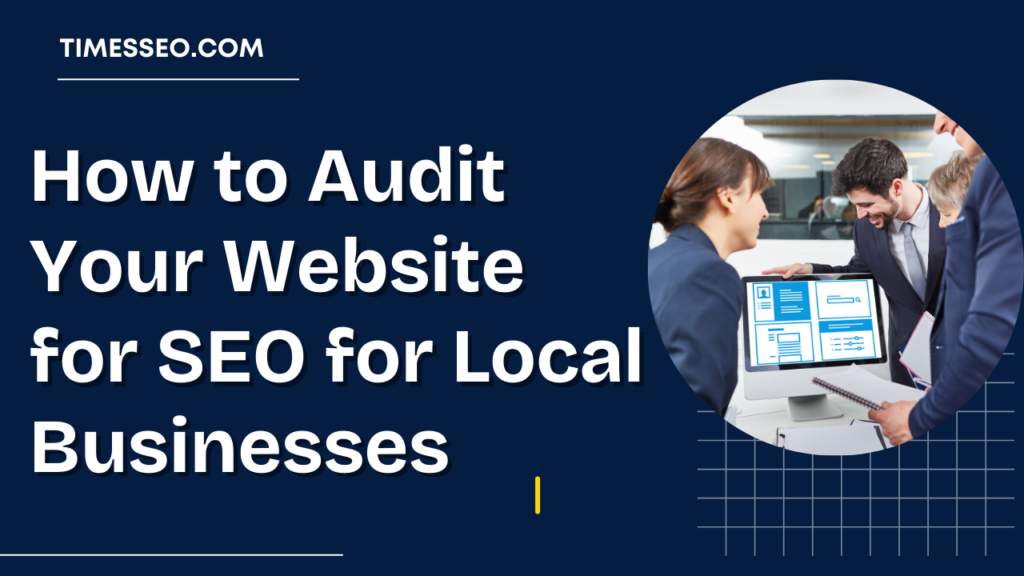
How to Audit Your Website for SEO for Local Businesses
Learn how to audit your website step by step and improve SEO for local businesses. Discover key strategies to boost visibility, trust, and customer conversions.
Table of Contents
Introduction
When was the last time you checked how well your website is optimized for your local customers? If the answer is “a while ago,” then you might be missing out on valuable leads and sales. Conducting a local SEO audit ensures your website is visible to nearby customers searching for your products or services.
In this article, we’ll walk step by step through how to audit your website for SEO for local businesses—making sure you stay ahead of competitors in your area.
Why Local SEO Matters for Businesses
The Power of Local Search
Did you know nearly 50% of Google searches are made with local intent? That means when people look for “restaurants near me” or “best plumber in [city],” they’re ready to buy. Without local SEO, your business might remain invisible to these high-intent customers.
How Customer Behavior Impacts Local Rankings
Customers often compare businesses based on reviews, website usability, and location-based relevance. You will lose leads to competitors whose websites are geared for local search engine optimization.
What Is a Local SEO Audit?
Defining the Audit Process
A local SEO audit is a step-by-step evaluation of your website and online presence to identify areas that need improvement for better local search rankings.
Benefits of Regular Audits
- Improved visibility in local search results
- Increased foot traffic and inquiries
- Better user experience for local visitors
- Higher conversions and sales
Step 1: Check Website Technical Health
Site Speed and Mobile Optimization
Today’s visitors demand that pages open within three seconds. A slow site can drive visitors away. Use tools like Google PageSpeed Insights or GTmetrix to analyze speed and fix issues. Also, ensure your site is mobile-friendly, since most local searches happen on smartphones.
Crawlability and Indexing
Search engines need to access your website without issues. Check robots.txt, XML sitemaps, and canonical tags to ensure Google can crawl your site properly.
Fixing Broken Links and Redirects
Broken links not only frustrate visitors but also damage your SEO. Regularly scan for broken links and fix them with 301 redirects.
Step 2: Optimize Google Business Profile
Claiming and Verifying Your Listing
Your Google Business Profile (GBP) is your most powerful local SEO tool. To take charge of how your company shows up on Google Maps and Search, claim and validate it.
Adding Accurate NAP Details
Ensure your Name, Address, and Phone number (NAP) are accurate and consistent across all platforms. Even minor mismatches can hurt rankings.
Step 3: Local Keyword Research and Optimization
Targeting Location-Specific Keywords
Focus on keywords like “SEO services in [city]” or “best dentist near [location].” These draw in local searchers ready to take action.
Using Long-Tail Local Phrases
Instead of competing for broad keywords, use long-tail local terms like “affordable plumbing repair in Brooklyn” to attract targeted leads.
Step 4: On-Page SEO for Local Businesses
Title Tags, Meta Descriptions, and Headers
Optimize every page with relevant local keywords. For example, instead of “Best Bakery,” use “Best Bakery in Austin, TX.”
Schema Markup for Local SEO
Structured data helps Google understand your business details. Use LocalBusiness schema to highlight your address, reviews, and services.
Step 5: Content Audit and Local Content Strategy
Evaluating Existing Content
Review all current content to see if it aligns with local search intent. Outdated or irrelevant posts should be updated or removed.
Creating Localized Landing Pages and Blogs
Add service pages tailored to each location you serve. Local relevance is further increased with blog entries regarding news, events, or community updates.
Step 6: Backlink and Citation Audit
Importance of Local Citations
Citations (business mentions in directories like Yelp, Yellow Pages, etc.) strengthen your local SEO credibility. Ensure your details are consistent.
Building Relevant Backlinks
Backlinks from local news sites, chambers of commerce, or industry blogs can dramatically improve your authority in local searches.
Step 7: User Experience (UX) and Conversion Factors
Site Navigation and Usability
A simple, clean design ensures visitors find what they’re looking for quickly. Intricate navigation annoys users and increases bounce rates.
Clear CTAs for Local Customers
Make it easy for customers to call, book an appointment, or visit your store with clear calls-to-action (CTAs).
Step 8: Reviews and Online Reputation Management
Encouraging Customer Reviews
In addition to building trust, positive reviews have an impact on your local SEO rankings. Encourage happy customers to leave feedback.
Responding to Feedback
Always reply to reviews, whether positive or negative. This shows potential customers you value feedback and care about customer satisfaction.
Step 9: Social Media and Local SEO Integration
Engaging Local Audiences on Social Platforms
Social signals may not directly impact rankings, but active engagement with local audiences drives brand visibility and indirectly supports SEO.
Step 10: Tracking and Monitoring Performance
Using Analytics Tools
Leverage tools like Google Analytics, Google Search Console, and local SEO software to track traffic, leads, and keyword rankings.
Setting KPIs for Local SEO Success
Define KPIs such as calls, store visits, form submissions, or local keyword rankings to measure results.
Common Mistakes in Local SEO Audits
- Ignoring mobile optimization
- Using inconsistent NAP details
- Not leveraging Google Business Profile fully
- Failing to gather customer reviews
- Overlooking local backlinks
Conclusion
Connecting with local, ready-to-buy customers is just as important as raising your website’s ranks when you do an SEO audit for local businesses. By following the steps above, you’ll strengthen your local online presence, gain trust, and ultimately boost conversions.
Frequently Asked Questions
At least once every 6 months to ensure your website stays updated with the latest SEO practices.
Yes, positive reviews build trust and significantly impact local search visibility.
Absolutely! Local SEO levels the playing field by focusing on nearby customers rather than national audiences.
Tools like Google Search Console, Ahrefs, Moz Local, and BrightLocal are excellent choices.
Typically, improvements can be seen within 2–3 months, depending on competition and implementation.
Table of Contents
Popular Posts
-
 Affordable Technical SEO Audit for Small Business: A Complete Guide26 Jun 2025 Blog
Affordable Technical SEO Audit for Small Business: A Complete Guide26 Jun 2025 Blog -
 How to Get an Affordable Technical SEO Audit for Small Business27 Jun 2025 Blog
How to Get an Affordable Technical SEO Audit for Small Business27 Jun 2025 Blog -
 The Ultimate Local SEO Audit Checklist for Startups28 Jun 2025 Blog
The Ultimate Local SEO Audit Checklist for Startups28 Jun 2025 Blog -
 Local SEO Audit Checklist for Startups: A Beginner’s Guide28 Jun 2025 Blog
Local SEO Audit Checklist for Startups: A Beginner’s Guide28 Jun 2025 Blog -
 Top On-Page SEO Audit Steps for Service Websites Every Business Should Know29 Jun 2025 Blog
Top On-Page SEO Audit Steps for Service Websites Every Business Should Know29 Jun 2025 Blog -
 Technical SEO for WordPress: The Ultimate Beginner’s Guide01 Jul 2025 Blog
Technical SEO for WordPress: The Ultimate Beginner’s Guide01 Jul 2025 Blog -
 The Impact of On-Page SEO Audit Steps for Service Websites on UX01 Jul 2025 Blog
The Impact of On-Page SEO Audit Steps for Service Websites on UX01 Jul 2025 Blog -
 Technical Mobile SEO Audit Tips for Developers02 Jul 2025 Blog
Technical Mobile SEO Audit Tips for Developers02 Jul 2025 Blog -
 Complete SEO Backlink Audit Guide for Better Google Rankings03 Jul 2025 Blog
Complete SEO Backlink Audit Guide for Better Google Rankings03 Jul 2025 Blog -
 Boost Your Rankings with Technical SEO for WordPress01 Jul 2025 Blog
Boost Your Rankings with Technical SEO for WordPress01 Jul 2025 Blog







